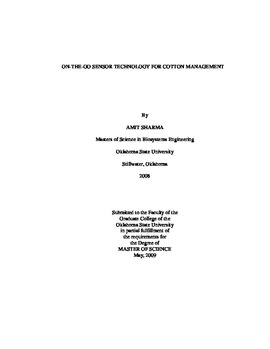| dc.contributor.author | Sharma, Amit | |
| dc.date.accessioned | 2014-02-25T00:21:17Z | |
| dc.date.available | 2014-02-25T00:21:17Z | |
| dc.date.issued | 2009-05-01 | |
| dc.identifier.uri | https://hdl.handle.net/11244/7969 | |
| dc.description.abstract | This study was conducted on cotman cotton using on-the-go sensors. The aim of this study was to evaluate the use of on-the-go sensor technology to map cotton for the application of PGR. On-the-go sensor system can be used to make automatic real time PGR and defoliant sprayer in future and can limit the use of remote sensing and aerial imagery which is otherwise very expensive, needs lot of lab work and can not be used to make automatic real time sprayers. In this study on-the-go NDVI sensors and ultrasonic height sensors were used to evaluate relationships between NDVI, plant height measured by the sensors and different cotton structural parameters. Also to define, cotton structural parameters as function of NDVI and plant height measured by the on-the-go sensors. For this, experiments were conducted near Altus, OK in 2007. Different nitrogen treatments were given to the different plots with in the field to create spatial variability for height and NDVI. Data measured by sensors were compared with manually measured crop structural parameters recorded at different growth stages. Manually measured plant height was observed as a function of NDVI, which infers that NDVI sensors can be used to measure cotton height. Height to node ratio was also found to be correlated with NDVI with low level of significance. On the other hand height to node ratio was found to be correlated with cotton height measured by the ultrasonic sensors with high level of significance. Also it was concluded that the plant height can be measured using on-the-go ultrasonic sensors, which brings the possibility that only ultrasonic sensors can be used to determine the rate of PGR application. Although, some satisfactory results were observed but still there is need to validate the results obtained in this study. In-addition, some recommendations related to testing of on-the-go sensor technology, have been suggested in the section on future recommendations. These recommendations can help in validating the results obtained in this study. | |
| dc.format | application/pdf | |
| dc.language | en_US | |
| dc.publisher | Oklahoma State University | |
| dc.rights | Copyright is held by the author who has granted the Oklahoma State University Library the non-exclusive right to share this material in its institutional repository. Contact Digital Library Services at lib-dls@okstate.edu or 405-744-9161 for the permission policy on the use, reproduction or distribution of this material. | |
| dc.title | On-the-Go Sensor Technology for Cotton Management | |
| dc.type | text | |
| osu.filename | Sharma_okstate_0664M_10195.pdf | |
| osu.college | Engineering, Architecture, and Technology | |
| osu.accesstype | Open Access | |
| dc.description.department | Biosystems and Agricultural Engineering | |
| dc.type.genre | Thesis | |
